As the archetypal bumper-sticker proclaims: "Being Paranoid Doesn't Mean that They Aren't Out to Get You." The world of the paranoiac is nothing but a teetering rock slide - impending destruction always hovering just a moment away. Some have suggested that a daily tablespoon full of this viewpoint can actually be a survival trait: In our capricious and elaborate world a certain degree of suspicion and caution will allow us to live to be frightened another day.
But the real terror is lurking just beyond that. As anyone who has studied nature can attest, the world and all its creatures (great as well as small) really are out to get us. Some of their attacks are easy to defend against, and we - in general - know how to survive them. Yet there are creatures on this globe that can snuff us out like a cheap candle in a stiff wind. - And I don't mean the cartoon ferocity of the lion, tiger, or bear who proclaim their dangerous potential with a growl, roar, or screech.
The deadliest (and easy to miss) critters lurk in dark silence, ready to strike with either the barest of warnings or none at all - and with absolutely fatal venom.
Some you've heard about, and so sit there and scoff. Yeah, big deal: rattlesnake, cobra, black widow -- either you can hear them coming, avoid going to India, or simply not stick your hands into dark places. They are nothing but annoyances: fatal only to the truly stupid, or very sick. Dangerous, sure, but deadly to only Darwin Award winners. But there are others, nasty little things as viscous and deadly as they are quiet and unassuming.
Say, for instance, you happen to be happily walking through the low surf merrily picking up and discarding shells, looking for just the right one to decorate your desk back at the office.
With no warning at all, however, you feel a sharp sting from one of those pretty shells -- a sting that quickly flares into a crawling agony. With that quick sting, the cone snail's barbed spear has insidiously injected you with one of the most potent neurotoxins in existence.
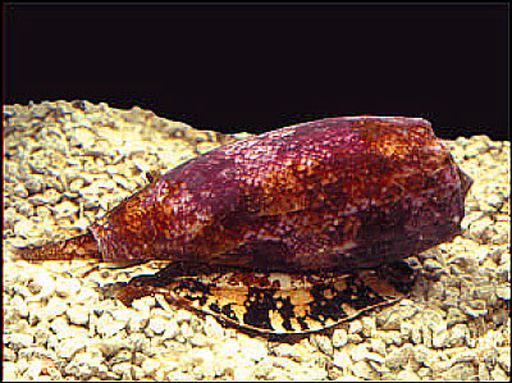 "The bright colors and patterns of cone snails are attractive to the eye, and therefore people sometimes pick up the live animals and hold them in their hand for a while." Meanwhile the snail may fire its harpoon, loaded with venom (the harpoon can penetrate gloves and even wetsuits)
"The bright colors and patterns of cone snails are attractive to the eye, and therefore people sometimes pick up the live animals and hold them in their hand for a while." Meanwhile the snail may fire its harpoon, loaded with venom (the harpoon can penetrate gloves and even wetsuits)
 "The bright colors and patterns of cone snails are attractive to the eye, and therefore people sometimes pick up the live animals and hold them in their hand for a while." Meanwhile the snail may fire its harpoon, loaded with venom (the harpoon can penetrate gloves and even wetsuits)
"The bright colors and patterns of cone snails are attractive to the eye, and therefore people sometimes pick up the live animals and hold them in their hand for a while." Meanwhile the snail may fire its harpoon, loaded with venom (the harpoon can penetrate gloves and even wetsuits)Nerves short-circuited by this infinitesimally small amount of juice, in seconds the agony of where the stinger struck has faded into a heavy numbness. A relief, perhaps, but then it spreads and moments later the paralysis has seized the entire limb. Then the breathing troubles start ... and then, simply, your heart stops beating.
Yes, there are antivenoms available, but, frankly, with something that can kill in less than four minutes you'd have to carry it in your back pocket to survive. It wasn't just for their fondness for these pretty shells that lead the CIA to develop a weapon using this venom to dispatch enemies.
We'll be back to the ocean in a few paragraphs, but for the next dangerous denizen we have to visit the steaming Amazon:
 2. Poison Arrow Frog: Lethal Touch
2. Poison Arrow Frog: Lethal Touch
 2. Poison Arrow Frog: Lethal Touch
2. Poison Arrow Frog: Lethal TouchThat frog over there, for instance: that tiny, brilliantly colored tree frog. Doesn't he look like some kind of Faberge ornament, there against that vermilion leaf? Wouldn't such a natural jewel look just gorgeous in a terrarium back home?
Pick him and you'll be dead in a matter of minutes. One second frolicking in the undergrowth, the next spasming and foaming on the jungle floor. No stinger, no bite, no venom: just the shimmering slime covering his brilliant body.
The natives in these parts capture these poison arrow frogs (carefully) and coat their blowgun darts with that slime and knock full grown monkey's out of the trees with a single strike.
"They are the only animal in the world known to be able to kill a human by touch alone. They can jump as far as 2 inches."
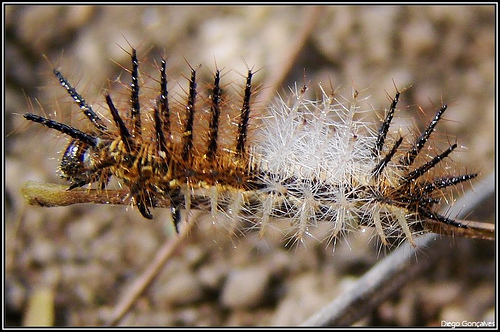 3. The lazy clown of the insect world.
3. The lazy clown of the insect world.
 3. The lazy clown of the insect world.
3. The lazy clown of the insect world.Not a long distance from the deep green of the Amazon, but good enough to completely exhaust the heartiest of hikers, is southern Brazil. Since we’ve had a pretty good trek your first reaction might be to rest a bit, to brace yourself against, perhaps, a tree for support. So what if you happen to touch a certain hairy caterpillar. It’s just a caterpillar, right? The lazy clown of the insect world. One problem, though: the crushie happened to be a member of the lonomia family of moths.
The adult moth is just a moth, but the hairs of the caterpillar are juicy with nasty stuff, so nasty that dozens of people die every year from just touching them. By the way, it’s not a good way to go, either: their venom is a extremely powerful anticoagulant, death happening as the blood itself breaks down. Not fun. Very not fun.
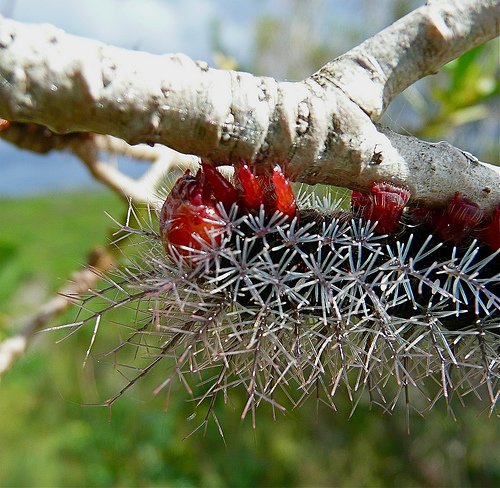 Back in the windswept sea, sharks announce their presence with a steady da-dum, da-dum, da-dum of background music; rattlesnakes... well, they rattle; lions, and tigers, and bears as said roar and bellow. These dangers are loud, almost comical: they parade their danger. But as paranoiacs know, these are nothing but part of the grand deception: they make us believe that everything fatal comes with sirens of intent, or brilliant warning labels. The real monsters are more devious than that; they lurk on the other side of invisibility, never make a sound, and kill you faster than the sounding of that first note in a shark's theme song.
Back in the windswept sea, sharks announce their presence with a steady da-dum, da-dum, da-dum of background music; rattlesnakes... well, they rattle; lions, and tigers, and bears as said roar and bellow. These dangers are loud, almost comical: they parade their danger. But as paranoiacs know, these are nothing but part of the grand deception: they make us believe that everything fatal comes with sirens of intent, or brilliant warning labels. The real monsters are more devious than that; they lurk on the other side of invisibility, never make a sound, and kill you faster than the sounding of that first note in a shark's theme song.
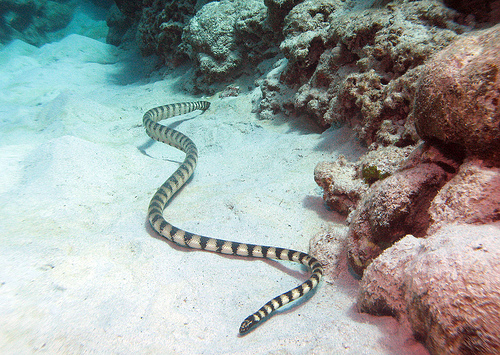 4. Beaked Sea Snake
4. Beaked Sea Snake
 Back in the windswept sea, sharks announce their presence with a steady da-dum, da-dum, da-dum of background music; rattlesnakes... well, they rattle; lions, and tigers, and bears as said roar and bellow. These dangers are loud, almost comical: they parade their danger. But as paranoiacs know, these are nothing but part of the grand deception: they make us believe that everything fatal comes with sirens of intent, or brilliant warning labels. The real monsters are more devious than that; they lurk on the other side of invisibility, never make a sound, and kill you faster than the sounding of that first note in a shark's theme song.
Back in the windswept sea, sharks announce their presence with a steady da-dum, da-dum, da-dum of background music; rattlesnakes... well, they rattle; lions, and tigers, and bears as said roar and bellow. These dangers are loud, almost comical: they parade their danger. But as paranoiacs know, these are nothing but part of the grand deception: they make us believe that everything fatal comes with sirens of intent, or brilliant warning labels. The real monsters are more devious than that; they lurk on the other side of invisibility, never make a sound, and kill you faster than the sounding of that first note in a shark's theme song. 4. Beaked Sea Snake
4. Beaked Sea SnakeAnother creature of nightmares that doesn’t come with a theme song is a strange import to the world aquatica. When you think snake you usually think of dry land. But if you go paddling around the Persian Gulf (or coastal islands of India) keep a wary eye out for the gently undulating wave of Enhydrina Schistosa.
It might not look dangerous, if anything it just looks odd to see a snake swimming in the sea, but don’t let your fascination for a "creature of the dry that lives in the wet" hypnotize you into getting too close.
The Hook-nose (or beaked) sea snake, to use its less scientific name, has one of the most potent venomous known. How potent? Well, visualize 1.5 milligrams. Not easy, is it? Such a small amount. But that’s all the venom enhydrina needs to, well, leave you "swimming with the fishes", as the mob likes to say.
"The snake is also eaten as meat by Hong Kong and Singapore fishermen and locals alike"
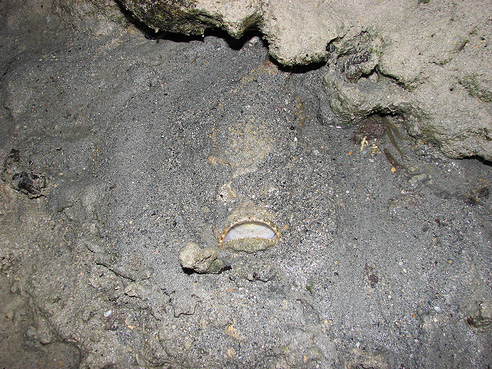 5. Stone Fish waits for you to step on it
5. Stone Fish waits for you to step on it
 5. Stone Fish waits for you to step on it
5. Stone Fish waits for you to step on itBut it’s not time to leave the sea quite yet. There are two nasty things in the blue depths you should spend many a sleepless night frightened of. For the big one you’ll have to wait a bit, for the one right below it in terrifying lethality you just have to watch your step when you’re walking along the bottom of the ocean.
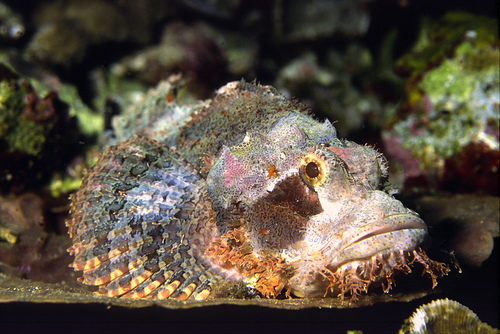 That’s all it takes: the spines on the fish’s back are like a parade of loaded hypodermic needles, each one carrying enough bad stuff to kill even a buff diver in a matter of minutes. But death is not really the worst.
That’s all it takes: the spines on the fish’s back are like a parade of loaded hypodermic needles, each one carrying enough bad stuff to kill even a buff diver in a matter of minutes. But death is not really the worst.
Like all monsters it hides, camouflaging itself among the rocks on the bottom. It’s what’s called an ambush predator: a critter that waits until something juicy walks, or swims, by. But what it could do to you requires no motion at all. All the stone fish has to do is just sit there on the bottom and wait for you to innocently step on it.
 That’s all it takes: the spines on the fish’s back are like a parade of loaded hypodermic needles, each one carrying enough bad stuff to kill even a buff diver in a matter of minutes. But death is not really the worst.
That’s all it takes: the spines on the fish’s back are like a parade of loaded hypodermic needles, each one carrying enough bad stuff to kill even a buff diver in a matter of minutes. But death is not really the worst.The pain from a stone fish’s sting is said to be so horrible that sufferers have begged to have the pricked limb amputate rather than live with it for another moment.
In a word: Ouch!.
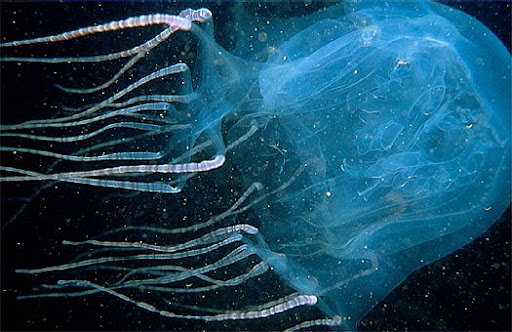 6. Box Jellyfish should really be called the "coffin" jellyfish
6. Box Jellyfish should really be called the "coffin" jellyfish
In a word: Ouch!.
 6. Box Jellyfish should really be called the "coffin" jellyfish
6. Box Jellyfish should really be called the "coffin" jellyfishCone shells, snakes, and caterpillars can be avoided, brilliant frogs warn of their fatality, and I’ve already warned you about the stone fish, but this last terror does not roar or display its danger at all. Let's take one final swim, shall we, this time off the coast of Australia? Incredible blue waters, shimmering sandy beaches, shrimps on the barbie... Skin divers rave about the Australian coast … those, that is, who never let their guard down for an instant.
Paddling in the crystal sea, enjoying the cool waters, the warm sun, it's easy to miss this monster, especially as it's almost as clear as the ocean. Chironex fleckeri doesn't sound terrifying, does it?
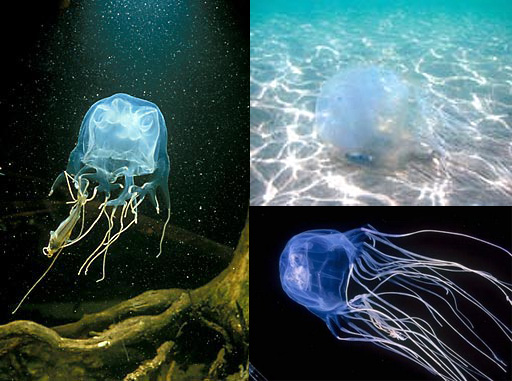 Chironex fleckeri: a tiny jellyfish found off the coast of Australia and southeastern Asia. Only about sixteen inches long, it has four eye-clusters with twenty-four eyes, its tentacles carry thousands of nematocysts, microscopic stingers activated not by ill-will but by a simple brush against shell, or skin. Do this and they fire, injecting anyone and anything with the most powerful neurotoxin known.
Chironex fleckeri: a tiny jellyfish found off the coast of Australia and southeastern Asia. Only about sixteen inches long, it has four eye-clusters with twenty-four eyes, its tentacles carry thousands of nematocysts, microscopic stingers activated not by ill-will but by a simple brush against shell, or skin. Do this and they fire, injecting anyone and anything with the most powerful neurotoxin known.
 Chironex fleckeri: a tiny jellyfish found off the coast of Australia and southeastern Asia. Only about sixteen inches long, it has four eye-clusters with twenty-four eyes, its tentacles carry thousands of nematocysts, microscopic stingers activated not by ill-will but by a simple brush against shell, or skin. Do this and they fire, injecting anyone and anything with the most powerful neurotoxin known.
Chironex fleckeri: a tiny jellyfish found off the coast of Australia and southeastern Asia. Only about sixteen inches long, it has four eye-clusters with twenty-four eyes, its tentacles carry thousands of nematocysts, microscopic stingers activated not by ill-will but by a simple brush against shell, or skin. Do this and they fire, injecting anyone and anything with the most powerful neurotoxin known.Stories abound of swimmers leaping from the cool Australian seas, skin blistered and torn from thousands of these tiny stingers, the venom scalding their bodies and plunging them into agonizing shock. The sting of a chironex fleckeri, also called the sea wasp, has been described by experts as horrifying torment.
Luckily it doesn't last long. Take that to heart dear, innocent reader, as you dog paddle through the ocean, walk on the beach, or trek through the forest. Safe in your ignorance that the world doesn't hide terrifying, hideous deaths. The hideous agony of sea wasp's sting doesn't last long.
Not long at all. In fact, the burning pain is over in just about the time it will take you to read this last paragraph (and you don't have to be a phenomenally slow reader), not even enough time to reach shore and call for help. Maybe as the venom works itself into your system, causing your nervous system to collapse, you'll realize that paranoiacs are right: that there really are dangerous things out there, things that'll kill you by pure reflex, by just crossing their paths. Thirty seconds isn't a long time, not long at all. But sometimes life, and death, lessons can come in very short periods.
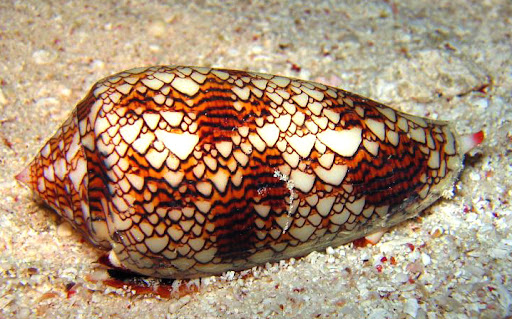





1 comment:
Very cool photos! I enjoyed looking at them.
Post a Comment